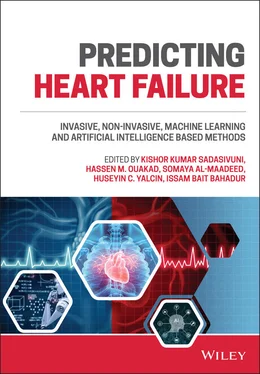Predicting Heart Failure
Здесь есть возможность читать онлайн «Predicting Heart Failure» — ознакомительный отрывок электронной книги совершенно бесплатно, а после прочтения отрывка купить полную версию. В некоторых случаях можно слушать аудио, скачать через торрент в формате fb2 и присутствует краткое содержание. Жанр: unrecognised, на английском языке. Описание произведения, (предисловие) а так же отзывы посетителей доступны на портале библиотеки ЛибКат.
- Название:Predicting Heart Failure
- Автор:
- Жанр:
- Год:неизвестен
- ISBN:нет данных
- Рейтинг книги:3 / 5. Голосов: 1
-
Избранное:Добавить в избранное
- Отзывы:
-
Ваша оценка:
- 60
- 1
- 2
- 3
- 4
- 5
Predicting Heart Failure: краткое содержание, описание и аннотация
Предлагаем к чтению аннотацию, описание, краткое содержание или предисловие (зависит от того, что написал сам автор книги «Predicting Heart Failure»). Если вы не нашли необходимую информацию о книге — напишите в комментариях, мы постараемся отыскать её.
Predicting Heart Failure: Invasive, Non-Invasive, Machine Learning and Artificial Intelligence Based Methods
Predicting Heart Failure
Predicting Heart Failure: Invasive, Non-Invasive, Machine Learning and Artificial Intelligence Based Methods
Predicting Heart Failure — читать онлайн ознакомительный отрывок
Ниже представлен текст книги, разбитый по страницам. Система сохранения места последней прочитанной страницы, позволяет с удобством читать онлайн бесплатно книгу «Predicting Heart Failure», без необходимости каждый раз заново искать на чём Вы остановились. Поставьте закладку, и сможете в любой момент перейти на страницу, на которой закончили чтение.
Интервал:
Закладка:
Masetic et al. 2016 [37] applied the random forest algorithm to ECG time series to detect CHF. The features on the ECG were extracted using the autoregressive Burg method. In the study, apart from the random forest algorithm, C4.5, SVM, ANN, and k-NN classifiers were used with the random forest algorithm giving the best performance.
Wu et al. [38] studied detecting HF prior to clinical diagnosis. Information such as electronic health records, health behavior, demographic data, clinical diagnosis, and clinical precautions were used to detect the disease in advance. SVM, boosting, and logistic regression were used for early detection of the disease. In addition, the contribution of feature selection to success was observed.
Aljaaf et al. [39] proposed a multilevel risk assessment for developing HF. With the help of the C4.5 classifier, estimates were made according to five different risk levels (1: No risk; 2: Low risk; 3: Moderate risk; 4: High risk; 5: Extremely high risk). The Cleveland heart disease data set was used in the study. A 10-fold cross-validation procedure was followed to evaluate the C4.5 classifier.
Zheng et al. [40] proposed a computer-aided diagnostic system for diagnosing HF. This system uses least-squares SVM (LS-SVM). The LS-SVM classifier gave better results than neural nets and hidden Markov models.
Pattekari et al. [41] designed a Naive Bayes-based smart system and developed a decision support system for HF prediction. With the web-based application, users were asked predefined questions and the estimation process was carried out by comparing their answers with the database.
Takcı [42] introduced a framework for the diagnosis of heart attack. In his study, in which the most successful classifier combination was sought with 12 different algorithms and four different feature selection methods, the most successful classifier was SVM using the linear kernel and the most successful feature selection method was the ReliefF algorithm. The obtained classification accuracy was reported as 84.81%.
Non-invasive techniques, such as electrocardiography, or invasive techniques, such as blood tests, which are used to diagnose HF, also measure irregularities in values. Imbalances and anomalies are measured with artificial intelligence techniques, such as the process performed with existing diagnostic techniques. Previously used conventional diagnostic techniques work by increasing capacity with the support of artificial intelligence. For example, it will be possible to increase the accuracy of diagnosis thanks to electrocardiography supported by artificial intelligence.
Table 1.2 Literature summary for artificial intelligence and machine learning techniques in HF.
| Author | Method | Study |
|---|---|---|
| Guidi et al. [24] | ANN, SVM, decision tree, fuzzy genetic algorithm | Clinical decision support system for HF |
| Elfadil et al. [25] | Neural nets and spectral analysis | HF patients grouping |
| Gharehchopoghi et al. [26] | ANNs | Decision support system for HF |
| Candelieri et al. [27] | Decision tree | To determine patient stabilization |
| Pecchia et al. [28] | Decision tree | To classify patients |
| Yang et al. [35] | SVM models | Heart attack prediction |
| Son et al. [36] | Logistic regression models | Distinguish between CHF and shortness of breath problems |
| Masetic et al. [37] | Random forest, C4.5, SVM, ANN, k-NN | Detect CHF |
| Wu et al. [38] | SVM, boosting, logistic regression | Detect HF |
| Aljaaf et al. [39] | C4.5 | Risk assessment for HF |
| Zheng et al. [40] | LS- SVM | HF diagnosis |
| Pattekari et al. [41] | Naive Bayes | HF prediction |
| Takcı [42] | 12 classification algorithms | Heart attack detection |
1.7 Conclusion and Future Directions
The heart is a vital organ for human beings. When it cannot healthily fulfill its duty it affects the quality of life and may even cause death. The inability of the heart to fully perform its functions, especially due to a heart attack, is called “heart failure.” There are several types and many causes of HF. High blood pressure, abnormal heart valves, and damage to the heart muscle are just a few of these causes.
Because of the importance of HF, its diagnosis is also very important. With timely diagnosis, heart patients are more likely to improve their quality of life and survive longer. Invasive and non-invasive procedures are classically used to diagnose the disease. Artificial intelligence and machine learning techniques have also been used for exploratory purposes due to the excessive causes of disease, the increasing number of patients, and patient data. Expert systems, image processing, machine learning, deep learning, and others, which are important fields of study of artificial intelligence, have been used extensively in this field recently. Artificial intelligence based methods both obtain data that could not be obtained before, and analyze previously obtained data more intelligently. Modeling of experiences with the help of machine learning and the use of models in diagnosing new patients have led to a striking development.
The most valuable contribution of artificial intelligence, especially machine learning techniques, to this field is their role in clinical decision support systems. Decision support systems, which were previously developed based on knowledge, now work based on data, thanks to machine learning. Machine learning models trained with disease data and previously given class information have become able to diagnose automatically. Clinical decision support systems, which have reached a certain stage with machine learning systems, have also reached a higher level with deep learning algorithms. Increasing data, complicated algorithm structures, and data relationships that could not be seen before are developing this field.
With a data-oriented and integrated clinical support system, a holistic medicine approach will now be applicable and the relationship between heart diseases and other diseases and even behavioral styles will be revealed. Diagnoses will become faster and more accurate through a more powerful data highway to be achieved thanks to 5G, the wider data holding capacity of cloud systems, more processing power from distributed processing architecture, and more complex and powerful algorithms with deep learning.
References
1 1Mayo Clinic. Heart Failure. https://www.mayoclinic.org/diseases-conditions/heart-failure/symptoms-causes/syc-20373142, Access date: May 1, 2021.
2 2MedicalPark, Kalp Yetmezliği Nedir? Belirtileri nelerdir? https://www.medicalpark.com.tr/kalp-yetmezligi/hg-2209. Access date: April 23, 2021.
3 3Cousins, S., Blencowe, N.S., and Blazeby, J.M.(2019). What is an invasive procedure? A definition to inform study design, evidence synthesis and research tracking. BMJ Open 9 (7): e028576. https://doi.org/10.1136/bmjopen-2018-028576.
4 4Invasive Tests and Procedures. Heart Attack and Stroke Symptoms. https://www.heart.org/en/health-topics/heart-attack/diagnosing-a-heart-attack/invasive-tests-and-procedures. Access date: April 23, 2020.
5 5Hannun, A.Y., Rajpurkar, P., Haghpanahi, M., et al. (2019). Cardiologistlevel arrhythmia detection and classification in ambulatory electrocardiograms using a deep neural network. Nature Medicine 25 (1): 65.
6 6Shamsham, Fadi, M.D.and Mitchell, Judith, M.D. (2000). Essentials of the diagnosis of HF. AFP Journal. Mar. 1, 2000. https://www.aafp.org/afp/2000/0301/p1319.html.
Читать дальшеИнтервал:
Закладка:
Похожие книги на «Predicting Heart Failure»
Представляем Вашему вниманию похожие книги на «Predicting Heart Failure» списком для выбора. Мы отобрали схожую по названию и смыслу литературу в надежде предоставить читателям больше вариантов отыскать новые, интересные, ещё непрочитанные произведения.
Обсуждение, отзывы о книге «Predicting Heart Failure» и просто собственные мнения читателей. Оставьте ваши комментарии, напишите, что Вы думаете о произведении, его смысле или главных героях. Укажите что конкретно понравилось, а что нет, и почему Вы так считаете.












